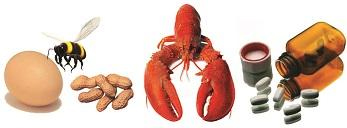3 - 5yrs Clinic
First Aid
Acute Allergic Reaction - how to help
All allergic reactions occur because the body's immune system reacts inappropriately in response to the presence of a substance that it wrongly perceives as a threat.
The body doesn’t react to the irritant directly, but reacts to the histamine produced by the body to fight the irritant.
- An acute allergic, or anaphylactic, reaction is caused by the sudden release of chemical substances, including histamine, from cells in the blood and tissues where they are stored. The release is triggered by the reaction between the allergic antibody (IgE) and the substance (allergen) causing the anaphylactic reaction. This mechanism is so sensitive that minute quantities of the allergen can cause a reaction.
- We have small amounts of histamine in our system normally and it is important for various vital functions of the body including regulating stomach acid and as a neurotransmitter in our nerve cells. However larger amounts of histamine being released leads to symptoms such as sneezing, blocked nose, itching… the sort of symptoms often associated with hayfever and mild allergies. Antihistamine medication can work effectively at resolving these symptoms but typically takes around 15 minutes to work.
Life threatening and systemic allergic reactions are caused by the body producing even more histamine, which dilates small blood vessels and causes them to leak, resulting in swelling in areas such as the lungs – leading to severe breathing problems. Sufferers may have a rash and be flushed due to the increased blood supply to the skin. Their blood pressure could drop dramatically and they may collapse.
The more times someone is exposed to the substance they react to, the quicker and more severe the reactions may be. If they don’t have a rash associated with the symptoms, it could still be an anaphylactic reaction, if they have a rapid onset of symptoms and may have been exposed to an allergen, treat as an anaphylactic reaction.
Who is at risk from anaphylaxis?
If a patient has suffered a bad allergic reaction in the past – whatever the cause, this may make them more prone to having further severe reactions. If a significant reaction to a tiny dose occurs, or a reaction has occurred with just skin contact, this could indicate that they are sensitive to this particular thing and greater contact could lead to a more severe attack. Asthma can put a patient in a higher risk category.

Common triggers for reactions
Individuals can react to absolutely anything, however most common causes include foods: such as peanuts, tree nuts (e.g. almonds, walnuts, cashews, and Brazil nuts), sesame, fish, shellfish, dairy products and eggs. Non-food causes include wasp or bee stings, natural latex (rubber), penicillin or any other drug or injection.
Exercise can also trigger an allergic reaction some time after the person has been exposed to something that they are allergic to.
How to recognise an acute allergic reaction?
A reaction can take any form and people who have reacted one way when exposed to a particular allergen can react completely differently on another occasion when exposed to the same thing. It is therefore extremely difficult to predict what a reaction might look like. The above picture is a very classic reaction and easily recognisable as Anaphylactic shock.
Common symptoms include:
- Generalised flushing of the skin
- A rash or hives anywhere on the body
- A feeling of anxiety or ‘sense of impending doom’
- Swelling of throat and mouth and difficulty in swallowing or speaking
- Alterations in heart rate – usually a speeding up of the heart
- Severe asthma attack which isn’t relieved by their inhaler
- Acute abdominal pain, violent nausea and vomiting
- A sudden feeling of weakness followed by collapse and unconsciousness
- A patient is unlikely to experience all of the above symptoms.
How to Treat Anaphylaxis
- The key advice is to avoid any known allergens if you are able to.
- Adrenaline auto-injectors are prescribed for those believed to be at risk. Adrenaline (also known as epinephrine) acts quickly to constrict blood vessels, relax smooth muscles in the lungs to improve breathing, stimulate the heartbeat and help to stop swelling around the face and lips.
- Acute Allergic reactions can be life threatening and it is crucially important that you recognise the problem and know what to do quickly in order to save someone’s life.
Adrenaline (US name: Epinephrine) is the first choice for an acute anaphylactic reaction and it works best if it is given as soon as you recognise that someone is having a reaction. You should administer the injector, or help the sufferer to administer it themselves, as quickly as possible and call for an ambulance stating clearly that the person is having an acute anaphylactic reaction. Adrenaline rapidly treats all of the most dangerous symptoms of anaphylaxis, including throat swelling, difficulty breathing, and low blood pressure.
Adrenaline is metabolised very quickly – it is very important that you call an ambulance as soon as an auto-injector has been given as its effects can wear off within about 15 minutes. Another injector can be given 5-15 minutes after the first if necessary.
There are currently 2 makes of Adrenaline Autoinjectors on the market in the UK; Epipen and Jext. Epipen is by far the most popular in the UK. www.epipen.com and www.jext.co.uk. Some people may have an Anapen, you activate the device by pressing the red button (videos as to how to use this device are widely available on-line.) This device has never been widely used in the UK and was withdrawn in September 2012.
Jext has recently launched. This is very similar in design and delivery to the Epipen and may well become a more popular option as it has a longer shelf life of 2 years. If you are prescribed an adrenaline auto injector you should carry it with you at all times and register it to receive a reminder when it is going out of date. If you have been prescribed 2 adrenaline injectors as a duo pack, you need to carry both with you at all times in case a second dose is needed. Teach friends and family what to do if they need to help you or someone else having an anaphylactic reaction.
Videos showing how to use adrenaline auto-injector are available on the drug company websites;
www.youtube.com/watch - shows how to use a Jext auto-injector
www.youtube.com/watch - shows how to use an Epipen
Hold the injector in your dominant hand, with the other hand remove the safety cap. Put the injector firmly into the upper outer part of the casualty’s thigh and hold it there for 10 seconds. Remove it carefully and they should feel better very quickly. If they do not recover swiftly, you may need to give another injector. Always phone an ambulance.
Patient Positioning for anaphylaxis
A child suffering from acute anaphylaxis is also likely to be showing signs of clinical shock
Reassuring the child and positioning them appropriately can make a major difference to their treatment. The child should also be kept warm and dry.
If a child is very short of breath, they should be encouraged to sit, in an upright position to help their breathing, putting something under their knees to help increase their circulation can be very helpful – into the lazy W position.
If a child is not having difficulty breathing, but is pale, cold, clammy, feeling sick and thirsty – they should lie down with their legs raised to help increase the circulation to their vital organs. Encourage them to turn their head to one side if they are likely to vomit. They should be covered to keep them warm and kept in this position until the paramedics arrive.
After an anaphylactic reaction:
An ambulance should always be called if someone is showing the signs of anaphylaxis and they will usually be admitted overnight for observation. This is because some people have a second reaction some hours after the first. Don’t forget to replace the used adrenaline auto-injector.
 First Aid for life provides this information for guidance and it is not in any way a substitute for medical advice. First Aid for Life is not responsible or liable for any diagnosis made, or actions taken based on this information. It is strongly advised that you attend a practical First Aid course to understand what to do in a medical emergency.
First Aid for life provides this information for guidance and it is not in any way a substitute for medical advice. First Aid for Life is not responsible or liable for any diagnosis made, or actions taken based on this information. It is strongly advised that you attend a practical First Aid course to understand what to do in a medical emergency.
For more information please visit www.firstaidforlife.org.uk
Related Articles
Nurseries: learning through fun
What is the Early Years Foundation Stage?
Koko Kids: a new design boutique
First Aid courses from an award winning London based company
First aid training that could help save a life
Greycoat Lumleys' Emergency nanny lifeline
A bright Montessori future in Brooke Green
Related Products
Baby Bjorn, Babysitter Balance
Baroo, cotbed duvet and pillow set
Verbaudet, French maternity, baby and children's clothing
Have Your Say
Be the first person to comment on this article, just post a comment below.






In order to post a comment you need to be a member. Join Now | Sign in